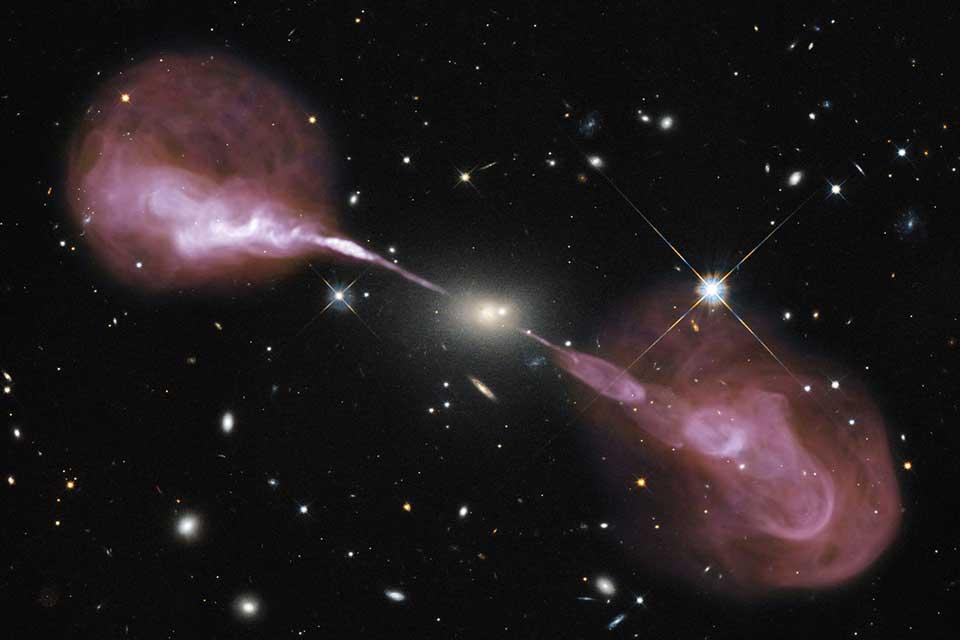Scientists could turn to black holes to complement facilities searching for dark matter and similarly elusive particles that hold clues to the universe’s deepest secrets, a new study by Oxford researchers suggests. The findings could help complement research complexes such as the Large Hadron Collider at CERN, the largest and highest-energy particle accelerator in the world. The research has been published today in Physical Review Letters.
‘One of the great hopes for particle colliders like the Large Hadron Collider is that it will generate dark matter particles, but we haven't seen any evidence yet,’ said study coauthor Professor Joseph Silk, a researcher at the University of Oxford and an astrophysics professor at Johns Hopkins University. ‘That's why there are discussions underway to build a much more powerful version, a next-generation supercollider. But nature may provide a glimpse of the future via super massive black holes.’
Particle colliders shoot protons and other subatomic particles at near light speed, smashing them against each other to expose the most fundamental aspects of matter. Subtle energy flashes and debris from the clash could reveal previously undiscovered particles, including potential candidates for dark matter, a critical but ghostly component of the universe that scientists have yet to detect. But black holes could offer an alternative approach to search for these elusive particles.
‘Particles plunging towards black holes can reach similarly high speeds to those in colliders, and if they collide near to the black hole’s event horizon they can reach extremely high energies,’ said study coauthor Dr Andrew Mummery, a theoretical physicist at the University of Oxford's Department of Physics. ‘We recently detected X-ray photons from some of these plunging black hole flows, so we know that they are out there in nature.’
Black holes can spin around their axis like planets, but with much greater energy owing to their intense gravitational fields. Scientists are increasingly discovering that some rapidly spinning massive black holes at the centres of galaxies can release enormous outbursts of energetic particles. It is these events that could potentially generate the same results as human-made supercolliders, the new study shows.
The study used simulations to show that collisions with gas plunging towards a black hole can reach extreme energies, with these collisions being much more violent than scientists previously thought possible. Although not identical, the collisions within plunging gas are similar to what scientists create by using intense magnetic fields to accelerate particles in the circular tunnel of a high-energy particle collider.
‘If supermassive black holes can generate these new particles by high energy proton collisions, then we might get a signal on Earth, some really high-energy particle passing rapidly through our detectors,’ adds Professor Silk, who is also a researcher at the Institute of Astrophysics in Paris. ‘That would be the evidence for a novel particle collider within the most mysterious objects in the universe, attaining energies that would be unattainable in any terrestrial accelerator. Something with a strange signature could even conceivably provide evidence for dark matter.
‘Some particles from these collisions go down the throat of the black hole and disappear forever,’ continues Professor Silk. ‘But because of their energy and momentum, some also come out, and it is those that come out which are accelerated to unprecedentedly high energies. We figured out how energetic these beams of particles could be: as powerful as you get from a supercollider, or more. It is very hard to say what the limit is, but they certainly are up to the energy of the newest supercollider that we plan to build, so they could definitely give us complementary results.’
According to the researchers, scientists could detect such high-energy particles by using observatories already tracking supernovae, massive black hole eruptions, and other cosmic events. These include detectors like the IceCube Neutrino Observatory in the South Pole or the Kilometer Cube Neutrino Telescope, which recently detected the most energetic neutrino ever recorded under the Mediterranean Sea.
‘The difference between a supercollider and a black hole is that black holes are far away,’ concludes Professor Silk, ‘but nevertheless, these particles will get to us.’
Black hole supercolliders, Mummery et al, 3 June 2025, Physical Review Letters.

